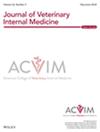Epidemiological Evaluation of Neuter Status, Sex, and Breed in Dogs With Cystine Uroliths
Abstract
Background
The majority of cystine uroliths occur in intact male dogs. Androgen-dependent (Type III) cystinuria is considered the most common cause.
Objectives
Identify dog breeds in which castration is likely to decrease the risk of cystine uroliths, the potential effect of delaying castration on cystine urolith formation, and urolith recurrence frequency.
Animals
Records of 5477 dogs with cystine uroliths and comparison groups without cystine uroliths (263 938 dogs with non-cystine uroliths and 44 491 dogs from a hospital population).
Methods
In this case-control study, odds ratios and 95% confidence intervals (CIs) were calculated to identify breeds where the proportion of intact males with cystine uroliths was higher than that of intact males without cystine uroliths.
The proportions of intact males forming cystine uroliths before 12, 24, and 36 months of age were calculated. Cystine urolith recurrence rates were assessed by breed in male dogs.
Results
Dogs with cystine uroliths were 99% male. Across 60 breeds, the median proportion of male cystine urolith formers that were intact was 98% (range, 40%–100%). When compared with dogs without cystine uroliths, intact males were overrepresented in cystine urolith formers in all breeds except 8 (Akita, Belgian Malinois, Brussels Griffon, Cane Corso, Coonhound, Newfoundland, Scottish Terrier, and Silky Terrier). Diagnosis occurred before 36 months of age in 28% (n = 1328) of intact male cystine urolith formers. Cystine uroliths recurred in 5.0% (n = 255) of males; 81% (n = 207) were intact males.
Conclusions and Clinical Importance
Androgens likely play a role in the development of cystine uroliths across many dog breeds.


 求助内容:
求助内容: 应助结果提醒方式:
应助结果提醒方式:


